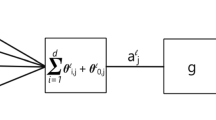Abstract
Dorst/van den Boomgaard and Maragos introduced the slope transform as the morphological equivalent of the Fourier transform. Generalising the conjugacy operation from convex analysis it formed the basis of a morphological system theory that bears an almost logarithmic relation to linear system theory; a connection that has not been fully understood so far. Our article provides an explanation by disclosing that morphology in essence is linear system theory in specific algebras. While linear system theory uses the standard plus-prod algebra, morphological system theory is based on the max-plus algebra and the min-plus algebra. We identify the nonlinear operations of erosion and dilation as linear convolutions in the latter algebras. The logarithmic Laplace transform makes a natural appearance as it corresponds to the conjugacy operation in the max-plus algebra. Its conjugate is given by the so-called Cramer transform. Originating from stochastics, the Cramer transform maps Gaussians to quadratic functions and relates standard convolution to erosion. This fundamental transform relies on the logarithm and constitutes the direct link between linear and morphological system theory. Many numerical examples are presented that illustrate the convexifying and smoothing properties of the Cramer transform.
Similar content being viewed by others
References
Akian, M., Quadrat, J.-P., and Viot, M. 1994. Bellman processes. In ICAOS ′94: Discrete Event Systems, volume 199 of Lecture Notes in Control and Information Sciences, Springer, London, pp. 302–311.
Alvarez, L., Guichard, F., Lions, P.-L., and Morel, J.-M. 1993. Axioms and fundamental equations in image processing. Archive for Rational Mechanics and Analysis, 123:199–257.
Azencott, R., Guivarc’h, Y., Gundy, R.F., and Hennequin, P.L. 1980. (eds.) Ecole d’Ete de Probalites de Saint-Flour VIII-1978, volume 774 of Lecture Notes in Mathematics. Springer: Berlin.
Baccelli, F., Cohen, G., Olsder, G.J., and Quadrat, J.-P. 1992. Synchronization and Linearity: An Algebra for Discrete Event Systems. Wiley, Chichester, www-rocq.inria.fr/scilab/cohen/SED/SED1-book.html
Bauer, H. 1990. Maß-und Integrationstheorie. Walter de Gruyter, Berlin.
Borwein, J.M. and Lewis, A.S. 1999. Convex Analysis and Nonlinear Optimization. Springer: New York.
Burgeth, B. and Weickert, J. 2003. An explanation for the logarithmic connection between linear and morphological systems. In L.D. Griffin and M. Lillholm, (Eds.), Scale-Space Methods in Computer Vision, volume 2695 of Lecture Notes in Computer Science, Springer, Berlin, pp. 325–339.
Castleman, K.R. 1996. Digital Image Processing. Prentice Hall: Englewood Cliffs.
Deuschel, J.-D. and Stroock, D.W. 1989. Large Deviations. Academic Press: Boston.
Dorst, L. and van den Boomgaard, R. 1994. Morphological signal processing and the slope transform. Signal Processing, 38:79–98.
Ellis, R.S. 1985. Entropy, Large Deviations, and Statistical Mechanics, volume 271 of Grundlehren der Mathematischen Wissenschaften. Springer: New York.
Florack, L. 1997. Image Structure, volume 10 of Computational Imaging and Vision. Kluwer: Dordrecht.
Florack, L. 2001. Non-linear scale-spaces isomorphic to the linear case with applications to scalar, vector and multispectral images. Journal of Mathematical Imaging and Vision, 15(1/2):39–53, 2001. Also: International Journal of Computer Vision, 42(1/2):39–53, 2001.
Florack, L.M.J., Maas, R., and Niessen, W.J. 1999. Pseudo-linear scale-space theory. International Journal of Computer Vision, 31(2/3):247–259.
Gonzalez, R.C. and Woods, R.E. 2002. Digital Image Processing. 2nd edition. Addison–Wesley, Reading.
Hamming, R.W. 1998. Digital Filters. Dover: New York.
Heijmans, H.J.A.M. 1994. Morphological Image Operators. Academic Press: Boston.
Heijmans, H.J.A.M. 2001. Scale-spaces, PDEs and scale-invariance. In M. Kerckhove, editor, Scale-Space and Morphology in Computer Vision, volume 2106 of Lecture Notes in Computer Science, Springer: Berlin, pp. 215–226.
Heijmans, H.J.A.M. and van den Boomgaard, R. 2001. Algebraic framework for linear and morphological scale-spaces. Journal of Visual Communication and Image Representation, 13(1/2):269–301.
Hiriart-Urruty, J.-B. and Lemarechal, C. 2001. Fundamentals of Convex Analysis.Springer: Heidelberg.
Iijima, T. 1959. Basic theory of pattern observation. In Papers of Technical Group on Automata and Automatic Control. December. IECE, Japan In, Japanese.
Iijima, T. 1973. Pattern Recognition. Corona Publishing, Tokyo, In Japanese.
Jackway, P.T. 1996. Gradient watersheds in morphological scale-space. IEEE Transactions on Image Processing, 5:913–921.
Jackway, P.T. and Deriche, M. 1996. Scale-space properties of the multiscale morphological dilation–erosion. IEEE Transactions on Pattern Analysis and Machine Intelligence, 18:38–51.
Lindeberg, T. 1994. Scale-Space Theory in Computer Vision. Kluwer: Boston.
Maragos, P. 1994. Morphological systems: Slope transforms and max-min difference and differential equations.Signal Processing, 38(1):57–77.
Maragos, P. 1996. Differential morphology and image processing. IEEE Transactions on Image Processing, 5(6):922–937.
Maragos, P. and Schafer, R.W. 1990. Morphological systems for multidimensional signal processing. Proceedings of the IEEE, 78(4):690–710.
Oberhettinger, F. and Badii, L. 1973. Tables of Laplace Transforms. Springer: Berlin.
Oppenheim, A.V. Schafer, R.W., and Buck, J.R. 1999. Discrete-Time Signal Processing. 2nd edition, Prentice Hall, Englewood Cliffs.
Rockafellar, R.T. 1970. Convex Analysis. Princeton University Press: Princeton.
Schavemaker, J.G.M., Reinders, M.J.T., Gerbrands, J.J., and Backer, E. 2000. Image sharpening by morphological filtering. Pattern Recognition, 33:997–1012.
Serra, J. 1982. Image Analysis and Mathematical Morphology, volume 1. Academic Press: London.
Serra, J. 1988. Image Analysis and Mathematical Morphology, volume 2. Academic Press: London.
Soille, P. 1999. Morphological Image Analysis. Springer: Berlin.
Sporring, J., Nielsen, M., Florack, L., and Johansen, P. 1997. (Eds.) Gaussian Scale-Space Theory, volume 8 of Computational Imaging and Vision. Kluwer: Dordrecht.
van den Boomgaard, R. 1992. The morphological equivalent of the Gauss convolution. Nieuw Archief Voor Wiskunde, 10(3):219–236.
Weickert, J., Ishikawa, S., and Imiya, A. 1999. Linear scale-space has first been proposed in Japan. Journal of Mathematical Imaging and Vision, 10(3):237–252.
Welk, M. 2003. Families of generalised morphological scale spaces. In L.D. Griffin and M. Lillholm, editors, Scale Space Methods in Computer Vision, volume 2695 of Lecture Notes in Computer Science, Springer: Berlin, pp. 770–784.
Witkin, A.P. 1983. Scale-space filtering. In Proc. Eighth International Joint Conference on Artificial Intelligence, Karlsruhe, West Germany, August volume 2, pp. 945–951.
Author information
Authors and Affiliations
Corresponding author
Additional information
First online version published in June, 2005
Rights and permissions
About this article
Cite this article
Burgeth, B., Weickert, J. An Explanation for the Logarithmic Connection between Linear and Morphological System Theory. Int J Comput Vision 64, 157–169 (2005). https://doi.org/10.1007/s11263-005-1841-z
Received:
Revised:
Accepted:
Issue Date:
DOI: https://doi.org/10.1007/s11263-005-1841-z



